If you are one of the ten people left on the planet who hasn’t tried your hand—or more accurately your spoon–at no-knead bread making, you’re really missing out. You could be enjoying fresh, fragrant, wholesome, and, yes, economical bread from your own oven whenever you like. This is possible even if you’re a newbie baker or yeast phobic. All of these snapshots are of Kneadlessly Simple breads just as they came out during testing in my kitchen. If you can read and measure, you can make—and have the pleasure of eating—breads just like these.I’ve posted three different recipes from Kneadlessly Simple to get you started. I’ve also included helpful hotlinks to Q & A’s, here including advice on the most common question, what kind of pot works best for no-knead breads here. Choose from my very popular Crusty White Peasant Pot Bread, (pictured below right, plus the olive variation is at the very top) all-purpose Easy Oat Bread, or hearty Seeded Pale Ale Pot Boule. (To be sure you don’t miss any of my info sign up for my free newsletter and recipes here. )
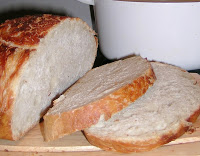
In case you’re still resistant to jumping on the no-knead bandwagon, check out this great review of Kneadlessly Simple by award winning journalist and former Washington Post food staffer, Jane Black. Or read these top reasons I hear for NOT doing so and why those reasons just aren’t valid.
1. I’m sure if I skip the kneading, the bread quality just won’t be very good.
In my no-knead method the kneading isn’t skipped—the dough just stands there and kneads itself. Really! When a slightly soft, slightly moist yeast dough sits and slowly rises over many hours, the natural release of gas bubbles due to yeast fermentation continuously bounces and shifts dough particles around. Given time, this bubbling, or “micro-kneading” action develops gluten just as effectively as traditional kneading, even though the activity may seem insignificant. (See how the bubbles have moved the dough in the pic on the right.) Actually, micro-kneading may develop the gluten even more thoroughly than human hands because they sometimes get tired and quit too soon! 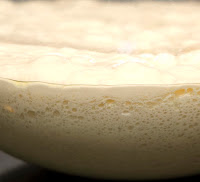 Besides allowing time for micro-kneading, the long, slow (12 to 20 hour) rise has another benefit: It provides the yeast plenty of opportunity to give the bread full-bodied taste and rich aroma. And while this happens, you can go off to work, or play, or to sleep and come back to find the “heavy lifting” done!
Besides allowing time for micro-kneading, the long, slow (12 to 20 hour) rise has another benefit: It provides the yeast plenty of opportunity to give the bread full-bodied taste and rich aroma. And while this happens, you can go off to work, or play, or to sleep and come back to find the “heavy lifting” done!
2. I can’t bake with yeast—I always get the temperature wrong & kill it. 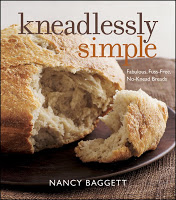 Kneadlessly Simple recipes are specifically designed so you can’t overheat the water and kill the yeast. In fact, the recipes always call for mixing doughs with ice water. Yes, that’s right—you stir fast-rising yeast into the dry ingredients; then form a dough using ice cold water. As long as you use a rapid-rising or bread machine yeast, it will not be harmed no matter how cold the water is. Another big advantage of using cold water is that it retards the yeast and causes the dough to rise very slowly. Professional artisan bakers and bread chemists say a long, slow rise delivers the best bread flavor and color, and I’ve definitely found this to be true. 3. I’m a traditionalist; I don’t find new-fangled methods ever as good as tried-and-true.
Kneadlessly Simple recipes are specifically designed so you can’t overheat the water and kill the yeast. In fact, the recipes always call for mixing doughs with ice water. Yes, that’s right—you stir fast-rising yeast into the dry ingredients; then form a dough using ice cold water. As long as you use a rapid-rising or bread machine yeast, it will not be harmed no matter how cold the water is. Another big advantage of using cold water is that it retards the yeast and causes the dough to rise very slowly. Professional artisan bakers and bread chemists say a long, slow rise delivers the best bread flavor and color, and I’ve definitely found this to be true. 3. I’m a traditionalist; I don’t find new-fangled methods ever as good as tried-and-true.
If you’re a real traditionalist, you should go “kneadless!” Letting the dough just sit and slowly ferment for a day or so was the completely natural way people first made bread thousands of years ago. Kneading was a technological innovation bakers introduced when they discovered that by pulling, beating, stretching, stirring, or otherwise “kneading” wheat doughs they could speed gluten development and get their job done faster! Kneading is, in essence, a clever trick for trimming some of the waiting time. But bakers have been kneading for so long, we now mistakenly consider this shortcut “traditional.” BTW, setting the dough aside and just letting yeast chemistry take its course turns out to very convenient for today’s lifestyles, when many of us are gone from the house for long hours. I’ve built in flex-bake steps so rising times can be lengthened or shortened to fit when you’re around and awake, instead of having to hang around waiting till it’s ready for you.
- I like kneading and hand-shaping yeast dough, so no-knead doesn’t seem like a big advantage to me.
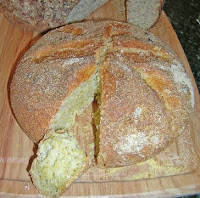 I’ve always loved kneading dough, too, but not the associated muss and fuss. Plus, like many folks, I’m often just too busy for it. With Kneadlessly Simple recipes, the dough gets mixed with a spoon in a big bowl (which literally takes under 10 minutes), then allowed to rise in the same bowl. After the first rise, the dough is simply stirred down in the bowl, then raised again—which leaves no annoying shower of flour or dough clumps on the counter to wipe up. Usually, shaping is automatically done by the baking container, further minimizing effort. Bottom line: No-knead can make it possible to squeeze in bread making when it otherwise won’t fit a busy schedule. I keep saying I’m going to go back to the old way, but so far, I haven’t found the time! And I’m not alone–Fleischmann’s Yeast did a survey of folks who had used Kneadlessly Simple and they not only liked the recipes, but over 60 percent said they made it possible to bake more often.
I’ve always loved kneading dough, too, but not the associated muss and fuss. Plus, like many folks, I’m often just too busy for it. With Kneadlessly Simple recipes, the dough gets mixed with a spoon in a big bowl (which literally takes under 10 minutes), then allowed to rise in the same bowl. After the first rise, the dough is simply stirred down in the bowl, then raised again—which leaves no annoying shower of flour or dough clumps on the counter to wipe up. Usually, shaping is automatically done by the baking container, further minimizing effort. Bottom line: No-knead can make it possible to squeeze in bread making when it otherwise won’t fit a busy schedule. I keep saying I’m going to go back to the old way, but so far, I haven’t found the time! And I’m not alone–Fleischmann’s Yeast did a survey of folks who had used Kneadlessly Simple and they not only liked the recipes, but over 60 percent said they made it possible to bake more often.
PS: For a hearty, easy soup to serve with your bread, try my easy Minestrone.
PPS: For a survey on how home bakers rated the no-knead method, click here.

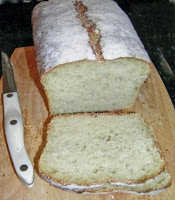
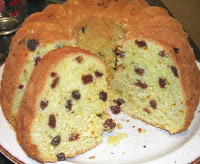


You have convinsed me to try these. Thank you.